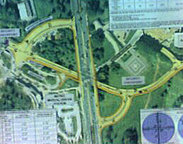There’s “no secret plan,” but we can’t reveal the plan
Montgomery BRAC Coordinator Phil Alperson posted an impassioned denial about the secret Beltway widening plans Cavan discussed earlier. However, his denial actually seems to admit that there is such a plan.
Alperson writes,
First, let me be clear that there is no plan, secret or otherwise, to widen the Beltway or construct a ramp into the Bethesda Naval Hospital campus.
However, later in his email, he says there is a plan:
Clark Construction is a local builder that is responsible for most of the ongoing BRAC-mandated hospital construction at Navy Med. Clark Representatives have attended monthly public meetings of the County’s BRAC Implementation Committee, a community-based advisory body, where the topic of a Beltway ramp frequently arises. Some people in the community and on the BRAC Committee support that concept because they believe it would allow Navy and NIH personnel direct access to their campuses without clogging local roads.
Clark came forward with an unsolicited plan they purported would address the Metro access issue and the Beltway issue. The State Highway Administration, which is the only body that can do anything on the Beltway (not the County) has rejected the Beltway concept as unfeasible for safety and environmental reasons, although it should be noted that SHA has never conducted a formal study on the matter. The Navy has also rejected it.
But area residents continue to call for a Beltway ramp. Montgomery County would like SHA to put the issue to rest, conclusively, once and for all by conducting a thorough and formal traffic and environmental study on a Beltway ramp so we can all know whether or not the concept is feasible and, even if technically feasible, whether it would relieve enough traffic to justify the enormous cost such a project would surely entail.
(Emphasis added). In other words, there’s no secret plan, but Clark suggested a plan and it’s secret. SHA and the Navy have said no but the County wants SHA to study it anyway.
I’m sure there are plenty of plans out there that nobody gives credence to. But they don’t conduct expensive studies on those either. This would all be a nonissue except for one key point: Montgomery County included this “secret plan” in the TIGER grant request, while redacting it from the public version. It’s not that someone suggested a bad plan that has everyone upset; it’s that the County turned around and submitted that plan to the federal government, and wants to study it, but still refuses to explain what’s in it.
Alperson addresses the secrecy:
I should point out that ACT has criticized the County for not making public the designs of what they call another “secret plan,” but the engineering designs of the pedestrian underpass are the intellectual property of Clark and are proprietary — the County is legally unable to release them to the public at this time but will do so when it becomes appropriate. ACT is aware of this legal encumberment but continues to accuse the County of “hiding a secret plan”. I should add that, contrary to other ACT accusations, the underpass design doesn’t include a “secret plan” for an interchange.
This sure looks like an interchange, even if engineers are calling it something else.
Alperson also claims that Clark’s plan is their “intellectual property.” He’s either misusing the term “intellectual property” or trying to hide behind it.
Copyright law only protects an actual work of creativity, not facts. Even if it prohibits the County from physically photocopying or emailing Clark’s documents, it doesn’t stop County officials from answering questions about the plans, just as the copyright on Harry Potter doesn’t stop me from telling you it’s about a young boy who discovers he has magical powers and that the first book involves a special stone
It’s possible that the County signed some sort of nondisclosure agreement where they promised not to reveal Clark’s plans. If that’s the case, it’s not “intellectual property,” but the County could be prohibited from discussing it. However, in that case, the question would be, why did they agree? Is it right for a governmental body to recommend a proposal and put it in a grant request but refuse to talk about it?
Again, we can separate the engineering details from the salient facts. It could be that Clark doesn’t want to share their specific estimates of cost, the materials they’d use, or the precise grade, since others might bid for the project if approved. However, the County should distinguish between sharing engineering details and actually answering questions about the key elements of the plan.
The biggest question of all is why the road is four lanes if it’s just supposed to service limited numbers of shuttle buses and emergency vehicles. Basically, there are numerous pieces that look like they fit into a larger plan for Beltway widening between 270 and the Medical Center campus, signs that such a plan was discussed, mysterious secrecy over all the details of the plan, and explanations from Montgomery County officials that don’t really fit the facts. Why not just come clean?

